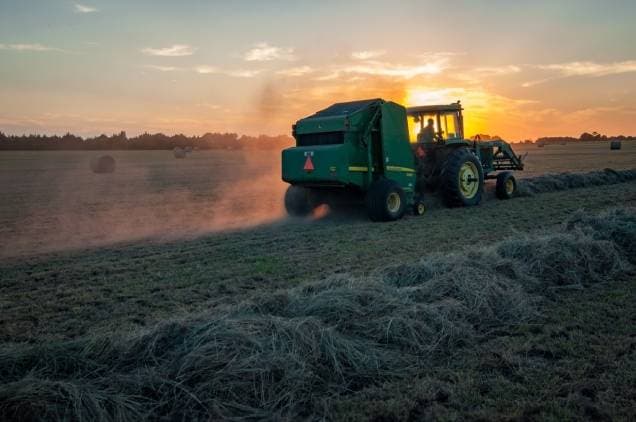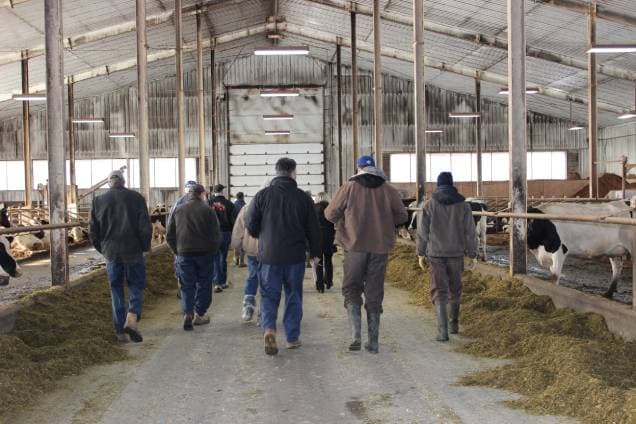 We learned from the Root of Your Back Story post that your feet can be the root of the problem for many farm incidents and injuries as well as a worker’s ability to maintain good physical condition. Standing and walking are required for a large portion of the work on the farm. It can start with foot wear, to slips trips and falls to impact injuries involving feet getting caught, cut, punctured or broken.
We learned from the Root of Your Back Story post that your feet can be the root of the problem for many farm incidents and injuries as well as a worker’s ability to maintain good physical condition. Standing and walking are required for a large portion of the work on the farm. It can start with foot wear, to slips trips and falls to impact injuries involving feet getting caught, cut, punctured or broken.
Evaluate the hazards on your farm. What hazards can cause foot problems or injuries? Working with livestock? Slips, Trips, & Falls? Working with Chainsaws? Broken or loose floor boards in the barn? Snow blower clogs? Nails or spikes coming out of floors? Contact with electricity? Poor housekeeping? Poor lighting? Incorrect footwear for the task or conditions? Ground and floor structure and condition? Runover by machine? Unguarded Mowers or Augers?
Consider not only injuries but conditions that can arise with standing and working on your feet all day such as blisters, calluses, bunions, plantar fasciitis, in grown toe nails and just plain tired feet. Standing all day can also have an effect on your back and joints including knees and hips which can lead to arthritis down the road.
To control these hazards let’s take a look at some of the possible controls.
Choosing the correct foot wear:
- Consider the potential hazards for the feet, a safety shoe or boot may be required. If so, choose one that meets CSA Standard Z195-14 “Protective Footwear” to protect against the identified hazard.
- Safety footwear help prevent injuries from punctures and electrical shock, reduces static electricity build up, and protects the toes from falling objects or anything that impacts the toe area.
- Ensure the shoe or boot fits correctly. Too small may cause foot cramping, where too big can cause blisters and slips and trips. Ensure the heel grips the foot firmly, there is room for the toes, and a low wide flat heel.
- Safety shoes do not stretch so be sure there is a correct fit before leaving the store.
- Buy shoes late in the day where the feet are apt to be at their largest due to swelling or flattening from being on them all day.
- Waterproof to prevent leaking and to keep feet dry throughout the day.
- Non-slip tread for the surface walked on. May need to speak to a sales person in regards to the right treat for the surface.
- Consider an insole for more cushion and to allow for more shock absorption while walking.
- Consult with a doctor if you have concerns with your feet or unsure of the type of footwear to buy.
- Check that the shoe or boot provides insulation in the winter and ventilation in the summer. You may need to change the safety shoe for the season and/or the work task.
- Inspect the footwear before use to ensure it is in the condition to perform the function for which it was designed. Holes, exposed steel toe or composite, worn tread, and loose soles will create additional unwanted hazards.
- Ensure workers wear the footwear as intended by lacing up the boots secure enough so they won’t come off and that the laces do not create an additional hazard.
Take care of your feet by:
- Wash them daily with soap and water, rinse thoroughly, and let dry. Don’t forget to do between the toes.
- On occasion use an Epsom Salts bath for the feet to detox the feet, aid in reducing the swelling, stiffness and pain, release stress, reduce foot odor, and increase blood flow.

- You may choose to use a foot powder. Consult with your doctor for any medicated regimes or remedies.
- On occasion use an Epsom Salts bath for the feet to detox the feet, aid in reducing the swelling, stiffness and pain, release stress, reduce foot odor, and increase blood flow.
- Wear a clean pair of socks each day. Keep spare socks on hand to change them throughout the day, if they get wet or soiled.
- Keep toe nails trim, but not too short.
- Wear shoes that fit correctly and meant for the task at hand.
- Ensure shoes are clean and dry on the inside.
What are you walking on?
Walking on natural surfaces can be more comfortable then walking on concrete but they typically offer more slip, trip and fall hazards. Slippery surfaces also offer more opportunity for slip, trips and falls.
Wood barn floors and rubber anti-fatigue mats on concrete are much kinder to the feet. This would be the same with safety shoes with shock absorbing insoles. Be sure the anti-fatigue mats are installed correctly and laying flat to prevent trip and fall hazards.
Other Preventative Measures include:
- Keeping pedestrians out of areas where mobile equipment is operated.
- Ensure machines and equipment are guarded at all times while in use.
- Do not remove clogs from snow blowers with hands or feet use a stick or pole.
- Wear boots specifically for protection against chainsaw cuts.

- Maintain good housekeeping.
- Check floors for nails and other objects that could puncture the foot. Make this habit a part of the monthly inspection process.
- Add lighting to dark areas.
- Mark edges of stairs.
- Post signs for the various protective footwear requirements for the task on the farm.
- Practice good animal handling techniques and avoid the animal’s blind spot.
- Keep all circuits closed in the electrical panel and check cords for frays and damage.



